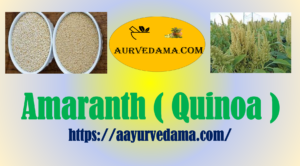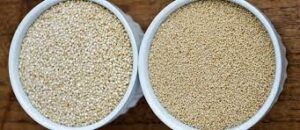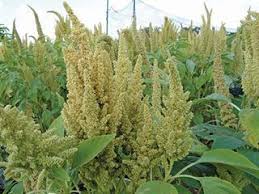Amaranth ( Quinoa )
Amaranth ( Quinoa ) : (Hindi. Chua, Chaulai, Kannada. Rajgiri Gujarati. Rajgiro English. Amaranth, Latin. Amaranthus paniculatus Kul-Amarantaceae). Cultivated for its leafy vegetables and seeds, this perennial herb (which completes its life cycle in one season) is native to East and West Asia and Africa and is cultivated everywhere in Maharashtra. 1·3 to 2 m. The trunk of this ornamental plant, which grows taller or taller, is thick and smooth or somewhat hairy, with deep lines on the branches. Leaves alternate (opposite), 5 to 15 × 2·5 to 10 cm. Size, 2·5 to 10 cm. The flowers are long-stalked, oblong-lanceolate, pointed and bronze or reddish in color; the flowers are solitary in red or golden yellow panicles [⟶ Puspabandha] and numerous. The grain in the center is the longest. Due to the attractive color of the grains, the amaranth fields add a lot of beauty to the surrounding area. Sepals (petal appendages) small, two, fine, needle-like and longer than the sepals, 2·5 to 3 mm long, sepals five, oblong to lanceolate and pointed, stipules (pun-saffrons) five, saffron free, keeled erect. , of a cup and contains a single seed, kinjle three, akhud [flower]. The fruit is dry and the globular seed is very small in size (1·5 to 1·9 mm. in diameter), somewhat round in shape and red, black or white in colour. Seeds contain good quality protein. The seeds are also known as Amaranth. Ladoo, vada etc. are made from pitha bread and flour. The seeds are soaked in water and milk and sugar are added to make pudding. Ko Wala is a leafy vegetable.

This plant is a diuretic (urinary cleanser) and is useful in goiter, urinary inflammation, blood disorders, hemorrhoids, etc.
Must Read
This crop is cultivated in the Himalayas from Kashmir to Sikkim at an altitude of 1,000 to 3,250 m. Up to the height, as well as the middle and south. In the hilly areas of India as well as Brahmadesh and U. and W. Grown as a winter crop in the plains of India. Two main types are found with golden yellow and shiny purple granules. The golden yellow grain type is more cultivated.
This crop is sown in May-June and harvested in October-November. In the plains, however, harvesting is done in February-March. It is taken as a separate crop or as a mixed crop with other crops.
The following three amaranth-like cultivars of the genus Amaranthus are cultivated in Tamil Nadu: A. Tristis (see Arakkerai), a. Gangeticus (T. Thandukkerai), A. Polygonoides (T. Sirukkerai). The above varieties have been found to contain 13·3 to 16·3% protein and 60 to 62·2% carbohydrates.

Amaranth ( Quinoa )
Crop
This crop is sown in summer and monsoon for leafy vegetables. Hectare Su. 22 quintals of vegetables are obtained. Vegetables contain vitamins A and C and iron.
Amaranthus species A. Caudatus is cultivated for its seeds in hilly areas of northern India. The seeds are called ‘Ramdana’ in that area and are used like amaranth. The tips of the leaves of this variety are angular (rounded tips) and A. In paniculatus species they are spear-shaped. Also A. The grains of the caudate species are elongated. In the Panniculatus variety they are upright growing.
In the mountainous regions of Mexico, Guatemala, and Peru, plants of the genus Amaranthus are cultivated for fodder. The trees look like ragi trees. These plants are known by the name amaranth. At the time of Christopher Columbus’ arrival in America, this crop was cultivated in thousands of hectares in Mexico. It had an important place in the diet of the Aztec people. Also, annual tribute was paid to the emperor in the form of crops. This crop is also cultivated to protect against the destructive forces of nature. Jai. When the Spanish general Hernando Cortez arrived in Mexico in 1519, he banned the cultivation of the amaranth crop to destroy the culture and religious festivals of the Aztecs, and the crop was destroyed in thousands of fields. Cultivators of this crop in violation of prohibition orders were punished with amputations and sometimes even death sentences, but the cultivation of this crop continued elsewhere in the mountainous regions of Central and South America.

Amaranth ( Quinoa ) Plant
etc. S. An important discovery was made in 1972 by John Downton, an Australian plant physiologist. This discovery has made the amaranth crop a curiosity in international research. Downton found amaranth seeds to be rich in protein and of high quality (the amino acid lysine in the protein is twice that of wheat, three times that of corn, and nearly equal to lysine in milk). However, large scale cultivation of this crop requires a lot of research and work is in progress. Scientists from various disciplines are involved in this work. Universities in the states of California, Pennsylvania, Iowa, Cornell and Michigan are cooperating in this work. A remarkable feature of this plant is its adaptation to its environment, its highly efficient photosynthesis (using energy from sunlight to make complex carbohydrates from carbon dioxide and water) and vigorous growth even under adverse conditions.
Also Read
Amaranth ( Quinoa ) benefits
1. Quinoa for weight loss
Quinoa is high in protein and fiber. Quinoa can be very important for people who are on a diet to lose weight.
Quinoa’s protein and fiber fills the stomach, which suppresses appetite and curbs the urge to overeat.
Quinoa has a low glycemic index which provides the body with energy slowly and does not cause hunger pangs.
Other good sources of fiber – chia seeds, ragi, oats, kharik, flax seeds
2.Helps balance blood sugar
Much research suggests that quinoa can improve triglyceride levels and manage blood sugar, but more research is needed.

Amaranth ( Quinoa ) Plant
3. May improve gut health
Research suggests that eating quinoa increases the diversity of gut bacteria and may improve gut health by reducing inflammatory symptoms such as colitis.
By acting as a prebiotic, quinoa provides fuel for beneficial gut bacteria, allowing them to thrive.
4. Rich in antioxidants
Antioxidants are important in fighting free radicals and various health ailments. This reduces the risk of cancer.
Quinoa is a very rich source of antioxidants, but keep in mind that processed quinoa contains more antioxidants than the raw seed.
5.Helps in lowering cholesterol
Better digestion of food reduces cholesterol. The fiber content of quinoa helps in better digestion.
One study found that consuming 50 grams of quinoa daily for 6 weeks reduced total cholesterol, triglycerides, and LDL cholesterol.Reference
7. Anti-inflammatory properties
Similar to garlic and cloves, quinoa has anti-inflammatory properties, anti-inflammatory substances like gamma-tocopherol, phenolic acids, cell wall polysaccharides are present in quinoa.
Source : Marathi Vishwakosh
Read More